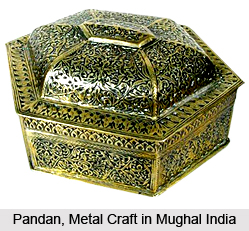 Pandan is another piece of art in the Mughal era. In fact one of the most beautiful objects of the Mughal Era was the gilt copper enamelled pandan. Just like huqqas pandans also come in a number of colours and shapes. In fact it can be said that the designs which were made in the Mughal era had a variety of shapes. Mostly the pandans came in gold and silver. The pandans which were found in the Mughal Era have that amalgam of rigorous geometry and fine floral open-work common to Mughal jalis. Its quatrefoil blossoms betray a Deccani origin and are very similar to those on a slightly earlier round brass incense burner. Pandans are also of various shapes. For instance octagonal in shape.
Pandan is another piece of art in the Mughal era. In fact one of the most beautiful objects of the Mughal Era was the gilt copper enamelled pandan. Just like huqqas pandans also come in a number of colours and shapes. In fact it can be said that the designs which were made in the Mughal era had a variety of shapes. Mostly the pandans came in gold and silver. The pandans which were found in the Mughal Era have that amalgam of rigorous geometry and fine floral open-work common to Mughal jalis. Its quatrefoil blossoms betray a Deccani origin and are very similar to those on a slightly earlier round brass incense burner. Pandans are also of various shapes. For instance octagonal in shape.
An important type of pandan of that age was an indented tear-drop pattern which covered the surface of a silver gilt pandan and tray. The gold pandans generally have lush green enamel covering inside. The three surfaces are engraved to form the radiating petals of great, full-blown lotuses. There are also pandans which combine the style of champleve and cloisonne. A similarly conceived polygonal gold pandan on a tray is depicted in a painting where it lies at the feet of a young Mughal prince enjoying a cooling bath at the side of a well.
Another example of a Pandan was a classically proportioned silver gilt pandan, with a flat dome and circular plan, has the tall flowers of the early eighteenth century. Its soft colours of two shades of green, yellow and white resemble those of the round huqqa and they were probably made at the same centre. Enamelling work reached a different dimension in the pandans. Rather it can be said Meenakari work exposed itself in a wonderful way through the gold and silver pandans. Enamelling in the pandans was of gold, silver and copper as well.
Historical records say that today only three pandans of quality survive. All of them were nearly the same size and of the same sort of enamel. The decorations consisted of twisting leaves and blossoms which were enclosed within rectangular panels. As peacock was a prominent motif even in the Pandan works. But besides peacocks other animals and birds were also used as motifs in the pandans of the Mughal Era.
Thus, in conclusion it can be said that pandan is a piece of art which explored all forms of artistry that was present during that age.



















